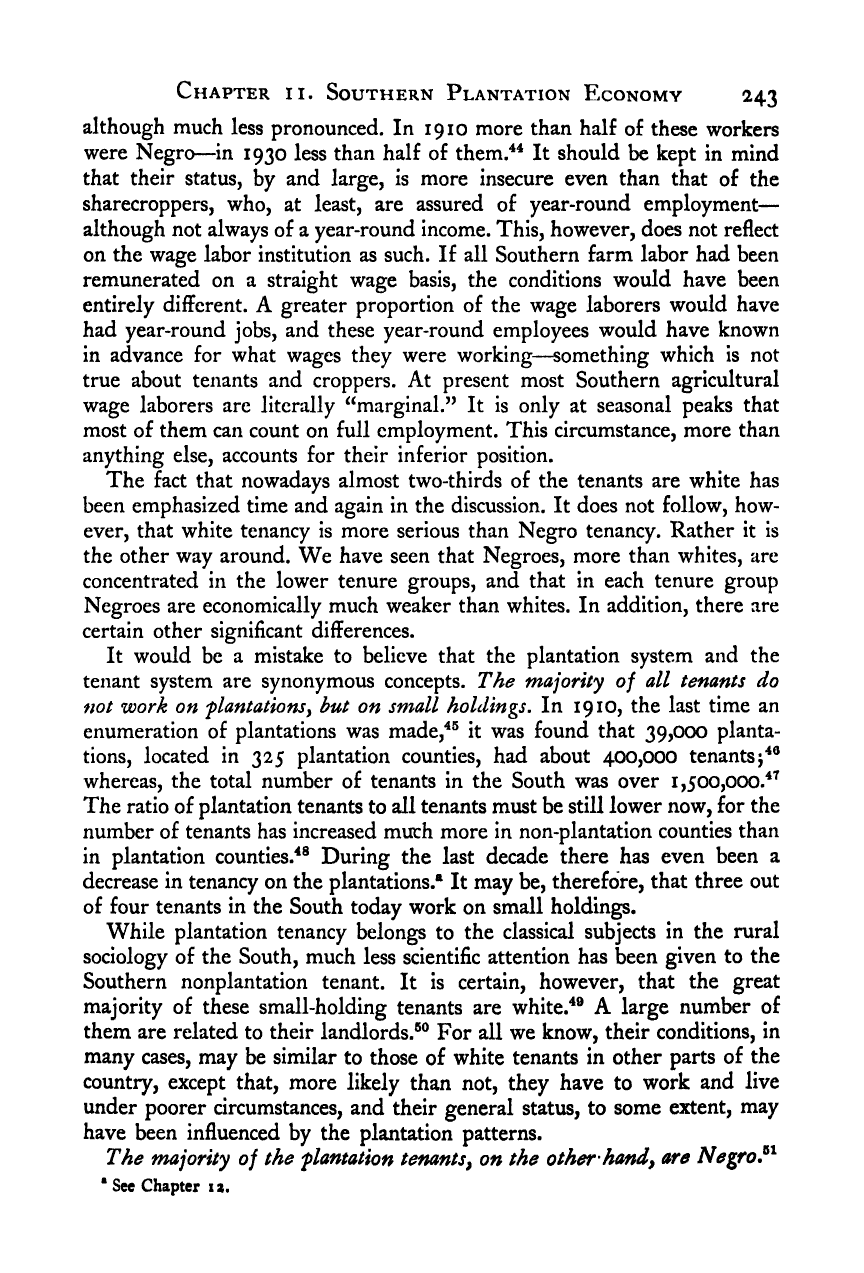Note: Gunnar Myrdal died in 1987, less than 70 years ago. Therefore, this work is protected by copyright, restricting your legal rights to reproduce it. However, you are welcome to view it on screen, as you do now. Read more about copyright.
Full resolution (TIFF) - On this page / på denna sida - IV. Economics - 11. The Southern Plantation Economy and the Negro Farmer - 8. Tenants and Wage Laborers

<< prev. page << föreg. sida << >> nästa sida >> next page >>
Below is the raw OCR text
from the above scanned image.
Do you see an error? Proofread the page now!
Här nedan syns maskintolkade texten från faksimilbilden ovan.
Ser du något fel? Korrekturläs sidan nu!
This page has never been proofread. / Denna sida har aldrig korrekturlästs.
Chapter ii. Southern Plantation Economy 243
although much less pronounced. In 1910 more than half of these workers
were Negro—in 1930 less than half of them.^^ It should be kept in mind
that their status, by and large, is more insecure even than that of the
sharecroppers, who, at least, are assured of year-round employment
—
although not always of a year-round income. This, however, does not reflect
on the wage labor institution as such. If all Southern farm labor had been
remunerated on a straight wage basis, the conditions would have been
entirely different. A greater proportion of the wage laborers would have
had year-round jobs, and these year-round employees would have known
in advance for what wages they were working—something which is not
true about tenants and croppers. At present most Southern agricultural
wage laborers are literally “marginal.” It is only at seasonal peaks that
most of them can count on full employment. This circumstance, more than
anything else, accounts for their inferior position.
The fact that nowadays almost two-thirds of the tenants are white has
been emphasized time and again in the discussion. It does not follow, how-
ever, that white tenancy is more serious than Negro tenancy. Rather it is
the other way around. We have seen that Negroes, more than whites, are
concentrated in the lower tenure groups, and that in each tenure group
Negroes are economically much weaker than whites. In addition, there are
certain other significant differences.
It would be a mistake to believe that the plantation system and the
tenant system are synonymous concepts. The majority of all tenants do
not work on flantationsy but on small holdings. In 19 lO, the last time an
enumeration of plantations was made,’^® it was found that 39,000 planta-
tions, located in 325 plantation counties, had about 400,000 tenants
whereas, the total number of tenants in the South was over 1,500,000.’*^
The ratio of plantation tenants to all tenants must be still lower now, for the
number of tenants has increased much more in non-plantation counties than
in plantation counties.**® During the last decade there has even been a
decrease in tenancy on the plantations.® It may be, therefore, that three out
of four tenants in the South today work on small holdings.
While plantation tenancy belongs to the classical subjects in the rural
sociology of the South, much less scientific attention has been given to the
Southern nonplantation tenant. It is certain, however, that the great
majority of these small-holding tenants are white.^® A large number of
them are related to their landlords.®® For all we know, their conditions, in
many cases, may be similar to those of white tenants in other parts of the
country, except that, more likely than not, they have to work and live
under poorer circumstances, and their general status, to some extent, may
have been influenced by the plantation patterns.
The majority of the ’plantation tenants^ on the other’ hand^ are Negro
* See Chapter x a.
<< prev. page << föreg. sida << >> nästa sida >> next page >>